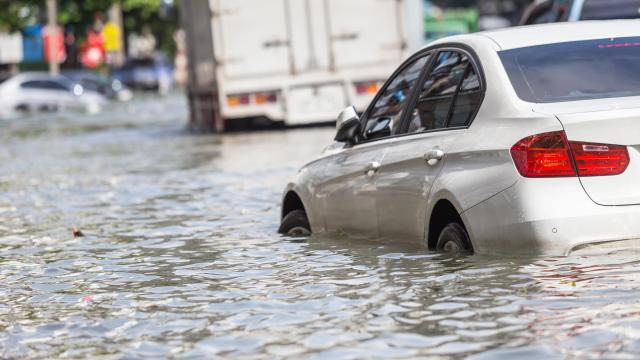The day before Superstorm Sandy slammed into my neck of the woods a decade ago, my wife asked if we should move our car off the street. I said, confidently and incorrectly, that our street didn’t typically flood, so we had nothing to worry about. A mere 24 hours and 1.2 m of water in my living room later, our car was floating serenely in the bathtub formerly known as my town.
As climate change produces more intense storms, there will be more and more flooded cars out there — and there are already hundreds of thousands. Whether your car is inundated while parked somewhere during a flash flood or if you make the dubious decision to drive into deep water and flood the car yourself, water can do an incredible amount of damage to your vehicle. Cars aren’t designed to handle water from the bottom-up, and the need to circulate air through your engine means there are plenty of ways for water to get inside the vehicle.
So what can you do if your car encounters deep water? It all depends on just how deep the water was — but there’s no winning in this scenario, only degrees of losing. Here’s what to do with a car that’s been flooded.
Safety first
First of all, don’t try to start your car after it’s been flooded until you’re reasonably sure it’s safe to do so. If water got into your engine, starting the car is a surefire way to make the damage so, so much worse. This is serious: Corroded electrical wiring could result in a fire or other dangerous situation.
Instead, take a few precautionary steps:
- Eyeball the water line. The exterior of your car should exhibit an obvious high-water mark. If that line isn’t too far up, you might be ok to start the vehicle.
- Disconnect the battery. If the water line indicates there’s potential water incursion in your engine, disconnect the battery before doing anything else. Electricity, water, and the human body are never a good combination.
- Look inside the vehicle. If the upholstery is water-soaked, you’ve got a difficult cleaning process ahead of you at minimum. If the water line reaches the bottom of your dashboard, most insurance companies will consider the car to be automatically totaled.
- Check the fluids and filters. Water droplets in the oil, a milky-looking transmission fluid, and a wet water filter are good indications you’ve got water in your engine. Under no circumstances should you attempt to start a waterlogged engine, unless you’re curious what it feels like to completely destroy a vehicle.
Even if your engine escapes damage, you’re not out of the woods. Water — especially salt water — will rapidly corrode and destroy most of your car’s components and wiring. That means you might be able to drive your car away, but you need to dry it out and clean it immediately if you’re going to salvage it — although you should take photos and see if you can get an insurance adjuster out to see it before you do anything. If you think there’s water in the engine, have the car towed and let a mechanic clean the water out of the cylinders, fuel tank, and other areas of the car.
Contact your insurance
Do you have comprehensive car insurance? Congratulations, it most likely covers flood damage. As noted, if the water line touches the dashboard your insurer will probably total your car automatically. In fact, some insurers will total any flooded car because cleaning that stinky sludge and repairing corroded parts is often more expensive than just settling for a new vehicle. If you’re not sure if your coverage includes water damage, file a claim anyway — and do it fast, because you’re probably not the only car owner in the area dealing with a car that’s suddenly transformed into a raft.
If you can’t easily repair the car, you have three choices:
- Rebuild it. If you know a lot about cars and have the tools, time, and workspace, you can try taking your vehicle apart, cleaning or replacing every single bit of it (you will be astounded where the water and mud managed to get into), and putting it back together. Your desire to do this is your business.
- Sell it. Yes, you can sell a flooded car. Scrap yards will happily pay you an insultingly small amount of money for your car, which is now just a collection of parts held together in the shape of a car. Individuals will also sometimes bargain hunt for a flooded car they can repair and rebuild themselves, but these sales can be tough — and it can take you a long time to find a buyer.
- Donate it. Yes, you can donate a flooded car. Charities will often come get your car, and you can claim the donation on your taxes and at least get some financial benefit from it.
Losing a car to flooding is expensive and a lot of trouble to deal with. That’s why it’s foolish to ever drive into deep water during a flood, and why you should always move your vehicle to higher ground when there’s a possibility of flooding in your area, as my wife will tell you repeatedly with only the slightest prompting while giving me the side-eye.

Leave a Reply
You must be logged in to post a comment.